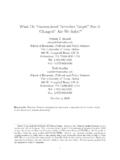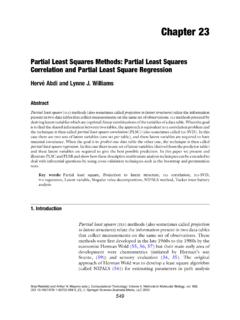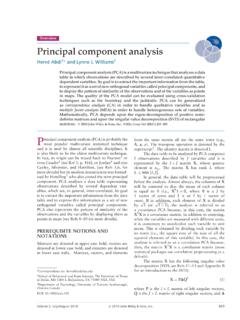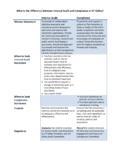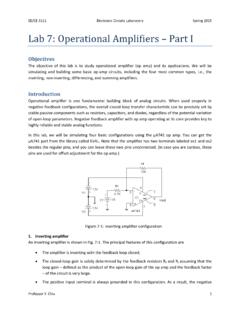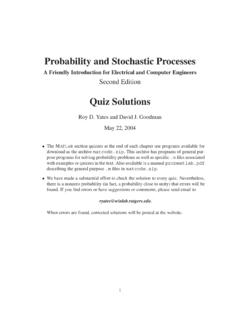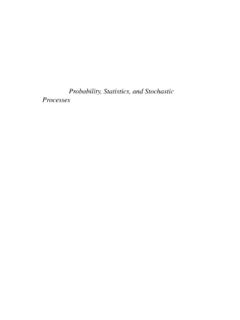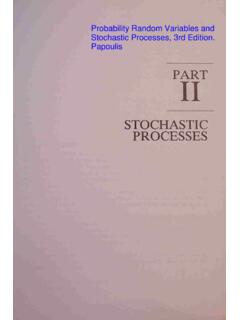Transcription of OPRE 7310 Probability and Stochastic Processes - …
1 OPRE 7310 probability and stochastic processes - SyllabusCourse InformationCourse number - section: OPRE 7310 - 001; Course title - term: Probability and Stochastic Processes - Fall hours: 1:00-3:45 pm on W @ MS Personnel Professor: Metin C akany ld r m , , MS Teams. Office hours: 4:30-6 pm on M @ MS Teams. Assistant: Abdullah G okc nar , , MS Teams. Office hours: 4:30-6 pm on T @ MS 2020 Announcements Instructional mode: Remote / Virtual on MS Teams platform. Asynchronous course access is participating in the course not at the same time as the instruction of the course according to Students can choose synchronous or asynchronous ac-cess. Synchronous / Asynchronous students have the same homeworks, exams and due dates.
2 Class Recordings: Students are expected to follow appropriate University policies and maintain the security ofpasswords used to access recorded lectures. Unless the Office of Student AccessAbility has approved the studentto record the instruction, students are expressly prohibited from recording any part of this course. Recordingsmay not be published, reproduced, or shared with those not in the class, or uploaded to other online envi-ronments except to implement an approved Office of Student AccessAbility accommodation. Failure to complywith these University requirements is a violation of the Student Code of Conduct at Class Materials: The Instructor may provide class materials that will be made available to all students reg-istered for this class as they are intended to supplement the classroom experience.
3 These materials may bedownloaded during the course, however, these materials are for registered students use only. Classroom mate-rials may not be reproduced or shared with those not in class, or uploaded to other online environments exceptto implement an approved Office of Student AccessAbility accommodation. Failure to comply with these Uni-versity requirements is a violation of the Student Code of Conduct at Online tools: This course uses online tools for lectures and communication. Students can learn more aboutthese tool at UT Dallas provides eLearning tech-nical support 24 hours a day, 7 days a week. The eLearning Support Center includes a toll-free telephone numberfor immediate assistance (1-866-588-3192), email request service, and an online chat service.
4 Distance Learning Student Resources: Online students have access to resources including the McDermottLibrary, Academic Advising, The Office of Student AccessAbility, and many others. Please see the eLearningCurrent Students webpage for more information. Server Unavailability or Other Technical Difficulties: The University is committed to providing a reliable learn-ing management system to all users. However, in the event of any unexpected server outage or any unusual tech-nical difficulty which prevents students from completing a time sensitive assessment activity, the instructor willprovide an appropriate accommodation based on the situation. Students should immediately report any prob-lems to the instructor and also contact the online eLearning Help Desk at The instructor and the eLearning Help Desk will work with the student to resolve any issues at theearliest possible time.
5 Academic Support Resources: The information contained at #academic-support-resources lists the University s academic support resources for all students. Comet Creed: This creed was voted on by the UT Dallas student body in 2014. It is a standard that Cometschoose to live by and encourage others to do the same: As a Comet, I pledge honesty, integrity, and service in all that I do. 1 Pre-requisitesCalculus; or consent of the DescriptionA large part of the course covers fundamental concepts and methods from the Probability theory. Special atten-tion is given to multivariate distributions, and convergence, classification and comparison of random variablesthat are useful in modelling business Processes .
6 The later parts of the course cover a number of useful classes ofstochastic Processes including discrete-time Markov chains, Poisson process and Brownian course is mainly designed as a first-year graduate course in Probability and with a consideration of theneeds of a PhD student in Management Sciences. Master of Science students can also take this course providedthat they have the pre-requisites. Especially current Master of Science students interested in pursuing their PhDdegrees later are advised to take this course, which is a core course in many PhD prepare students for research in Management Sciences, the course will have examples from different dis-ciplines such as Operations Management, Information Systems, Marketing, Risk Management and Objectives To introduce fundamental Probability concepts.
7 To illustrate these Probability concepts with examples from Management Books Introduction to Probability Models. Ross. 11th edition by Academic Press in 2014. Some but not allchapters are covered. Stochastic Processes . Ross. 2nd Edition. John Wiley & Sons 1996. Adventures in Stochastic Processes . S. Resnick. Birkhauser 1994. Comparison Methods for Stochastic Models and Risks. A. M uller and D. Stoyan. John Wiley & Sons 2002. How to Count? Beeler. Springer, 2015. The Brownian Motion: A rigorous but gentle introduction for economists. A. L offler and L. 2019. Mathematical Theoy of Reliability. Barlow and F. Proschan. 1965. Re-published as a Classic in AppliedMathematics in 1996 by SIAM.
8 To access a journal, go to the UTD Library web page and click on eJournals .Assignments & Grading Policy Students will be given +/- minus grades ( , A- or B+) based only on their mastery of the course material. 4% * Class attendance, and contribution to discussion and notes. 28% * Homework: About 7 HWs will be assigned. You may discuss homework problems with others, butyou must write up by yourself with the full understanding of what you write. Students handing in identicalassignments will be violating university regulations and will not receive credit! Late homeworks are not allowedunless you get permission at least one day in advance of the due date from the course TA. 34% * Exam 1.
9 Oct 14, Wednesday, TBD. 34% * Exam 2. Dec 2, Wednesday, Course Topics1 Module I: Introductory Probability : Defining Random Variables (RVs)Events, Measurability, Independence Events in countable/uncountable sample spaces and measurement of their Probability Monotone sets for exchanging limit and Probability Independence; Conditioning; Bayes theoremRandom Variables Discrete RVs: Bernoulli, Binomial, Geometric, Poisson; Sum and limit of discrete RVs Continuity notions; Heavy Tail; Continuous RVs: Uniform, Exponential, Pareto, Normal, Lognormal Moments and Moment generating functionsRandom Vectors Random Vectors: Joint and Marginal distributions Dependence, Covariance, Copulas Transformations of random vectors, Order statisticsModule II: Intermediate Probability : Manipulating RVsConditioning RVs Conditional Distribution of a RV Computing probabilities and expectations by conditioning Information Systems Application: Time-to-a-pattern for password securityInequalities and Limits of Events, RVs, Distributions Inequalities: Markov, Chebyshev, Jensen, H older.
10 Convergence of Sets, Probabilities and Distributions; Distributions of extreme Marketing Application: Multinomial choice modelClassifying and Ordering RVs Increasing failure rate and P olya densities Sochastic order, Hazard rate order, Likelihood ratio order, Convex order Risk Applications: Risk comparisons with convex orderModule III: Stochastic Processes : Indexing RVsMarkov Chains Markovian property and Transition probabilities Irreducibility and Steady-State probabilities Generic Applications: Hidden Markov ChainsExponential Distribution and Poisson Process Construction of Poisson Process from Exponential Distribution Thinning and Conditional Arrival Times Service Applications: Waiting TimesNormal Distribution and Brownian Process Construction of Brownian Process from Normal Distribution Hitting Times and Maximum Values Finance Applications: Option Pricing and Arbitrage Theorem1 OPRE 7311 provides more discussion of Discrete-Time Markov Chains and Poisson Processes , and a coverage of Continuous-timeMarkov Chains, Renewal Theory, and Queuing
